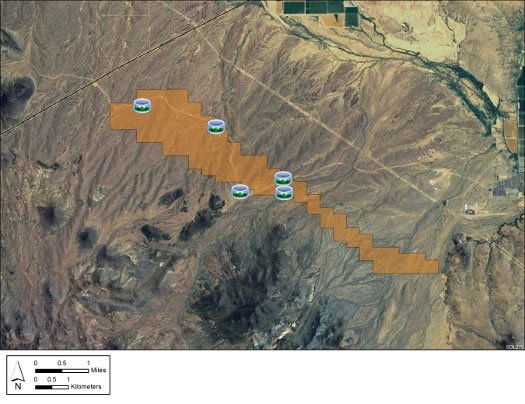The Approved Record of Decision for Resource Management Plan Amendments for Utility-Scale Solar Energy Development was issued on December 20th, 2024 — details are available on the BLM's Utility-Scale Solar Energy Development PEIS/RMPA webpage. Relevant information on the 2024 Western Solar Plan and the BLM's Renewable Energy Rule issued in July 2024, is in the process of being updated on this website.
| Arizona Variance Areas | Gillespie SEZ |
 |
 |
The Gillespie Solar Energy Zone (SEZ) is a designated leasing area (DLA) located in Arizona in a semiarid basin with undeveloped scrubland. The SEZ is located on BLM-administered land within the Lower Sonoran Field Office.
The Gillespie SEZ has a total area of 2,618 acres (11 km2). No changes were made to the boundaries of the Gillespie SEZ in the 2011 Supplement to the Draft Solar PEIS or the 2012 Final Solar PEIS, and no non-development areas were identified within the SEZ.
The Gillespie SEZ is located in Maricopa County in west-central Arizona. The SEZ is located to the southeast of the Harquahala Basin, in a valley between Gila Bend Mountains to the southwest and Centennial Wash to the northeast. In 2008, the county population was 3,958,263. The nearest town of Arlington is located about 7 mi (11 km) northeast of the SEZ.

Land within the Gillespie SEZ is undeveloped scrubland characteristic of a semiarid desert valley. Vegetation within the SEZ is predominantly creosotebush and other low shrubs, with areas of dark, volcanic rock. Several intermittent washes run through the SEZ in a southwest to northeast direction. Annual rainfall is less than 8 in. (20 cm).
The SEZ is undeveloped and rural, and contains a graded, county gravel road and other unpaved roads, and fencing. Part of the SEZ is authorized by the BLM for grazing.
The Palo Verde nuclear power plant, three natural gas power plants, a railroad, transmission lines, and a pipeline right-of-way are located in the surrounding area, which has few permanent residences.

The nearest major road access to the SEZ is via Old U.S. 80, which runs north-south 3 mi (5 km) from the eastern tip of the Gillespie SEZ. A 500-kV transmission line runs less than 1 mi (1.6 km) west of the SEZ.
In the 2012 Solar PEIS, the BLM committed to establishing a monitoring and adaptive management strategy for each solar energy zone (SEZ). Through these strategies, the BLM will take an active role in the collection of baseline data for the SEZs.
The BLM has not yet begun the monitoring and adaptive management strategy for the Gillespie SEZ. However, the BLM has conducted a pilot monitoring and adaptive management strategy for the Riverside East SEZ. In May 2016, the BLM released the Riverside East Solar Energy Zone Long Term Monitoring Strategy Final Report. The monitoring strategy document (PDF, 16.6 MB) is now available.
In the 2012 Solar PEIS, the BLM committed to preparing solar regional mitigation strategies (SRMSs) for the solar energy zones (SEZs). These regional mitigation strategies were intended to simplify and improve the mitigation process for future solar projects in SEZs.
On March 2, 2016, the BLM released the Regional Mitigation Strategy for the Arizona SEZs – Final Report (PDF, 5.5 MB). The Gillespie SEZ is included in the strategy. The strategy identifies mitigation priorities and options in advance of development, and takes into account the resource conditions of the land and regional trends informed by BLM's recent Rapid Ecoregional Assessments. The strategy was developed in collaboration with stakeholders to address key issues such as where and how mitigation may be achieved and the costs associated with doing so.
With IM-2019-018, the BLM established policy that compensatory mitigation could not be required as a condition for project approvals. However, with the issuance of IM 2021-038 on July 14, 2021, the BLM rescinded the previous IM-2019-018. The BLM expects to establish policies which are aligned with EO 13990, SO 3398, and the priorities of the Department. During this interim period offices should consider and implement compensatory mitigation on a case-by-case basis, in consultation with state office and national office program specialists and the Office of the Solicitor as needed.